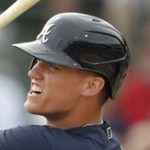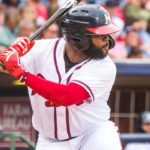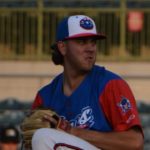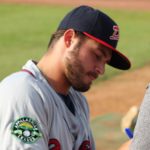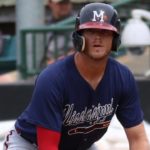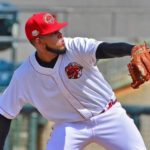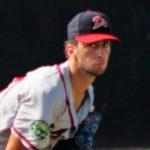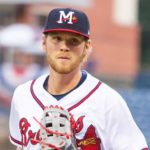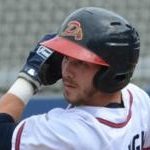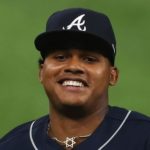 1. Cristian Pache, OF
1. Cristian Pache, OF
Age: 22 | Bats: R
2019: .277/.340/.462 | 126 wRC+ | 12 HR | 8 SB | 8.0 BB% | 22.7 K% (AA/AAA)
2020: 60-Man Player Pool
Acquired: International Amateur Free Agent – 2015
Prior Year Ranking: 1
If you have been following Pache’s steady rise through the Braves organization since 2016, it shouldn’t have come as a surprise that he took the Dodgers’ Julio Urias deep in Game 3 of the NLCS, and it certainly shouldn’t have been a surprise that he handled the centerfield position at short notice on baseball’s brightest stage. What was surprising — and encouraging — was the overall quality of Pache’s at-bats against the Dodgers as he displayed a willingness to go deep into counts and force the pitcher to come into the zone in order to get him out; even in his offensive breakout season in 2019 with AA Mississippi and AAA Gwinnett, Pache would too often give away at-bats by going after pitcher’s pitches early in the count.
This newfound patience works well with his good bat speed and the power he has added to his game along with the muscle steadily added to his 6′-2″ frame.
The time has come for Atlanta to permanently ensconce Pache in centerfield at SunTruist Park. He’ll have his up-and-downs like all young players, but he will be an impact player in all phases of the game with superstar potential, even if the his quieter personality may keep him overshadowed by friend and fellow outfielder Ronald Acuña Jr.
2. Ian Anderson, RHP
Age: 22
2019: 3.38 ERA | 3.55 FIP | 26 G, 26 GS | 135.2 IP | 4.31 BB/9 | 11.41 K/9 (AA/AAA)
2020: 60-Man Player Pool
Acquired: Drafted, 1st Round – 2016
Prior Year Ranking: 3
The Braves could have two strong contenders for NL Rookie Of the Year in 2021. In addition to Pache, Ian Anderson should begin the season with Atlanta after arriving in late August and helping turn around a battered and dismal starting rotation. In six starts for Atlanta in 2020, Anderson pitched to a 1.95 ERA in 32.1 innings, striking out 41 while walking only 14. In this he built off a strong 2019 minor league season which saw him refining his change-up into a true weapon.
The change-up works as well as it does thanks to Anderson’s ability to tunnel his delivery of it with his mid-90s four-seam fastball that he can capably elevate. He also has an above average curveball that shows plus at times; when he’s on his game he consistently drops the pitch down and away from right-handers and can use it to saw off left-handers before going back to either the fastball or change. It’s a potent arsenal.
Anderson also had 4 starts in the playoffs, giving up only 2 runs in 18.2 innings. With the additions of Charlie Morton and Drew Smyly and the return of Mike Soroka to the rotation, there will be less pressure on Anderson to perform up to the level of #2 starter for a World Series contender — but it’s nice to know that he’s willing and able to do that if called upon.
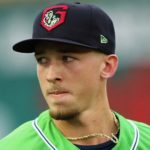 3. Drew Waters, OF
3. Drew Waters, OF
Age: 22 | Bats: S
2019: .309/.360/.459 | 132 wRC+ | 7 HR | 16 SB | 6.8% BB | 28.6% K (AA/AAA)
2020: 60-Man Player Pool
Acquired: Drafted, 2nd Round – 2017
Prior Year Ranking: 2
Waters came into spring training in 2020 looking to make an impression on the Atlanta coaching staff after a strong 2019 minor league season that saw him capture co-Organization Player of the Year honors (with Cristian Pache). Instead, Waters pressed at the plate and ended up striking out 14 times in 28 at-bats, reinforcing the more negative evaluations of prospect watchers, that he strikes out too much and that his success was fueled by unsustainable success on balls-in-play.
Because there wasn’t a 2020 minor league season, no one outside the organization knows the extent of the adjustments that Waters has made to make him more of an option for the major leagues in 2021, but reports have indicated that Waters worked especially on improving from the right side of the plate (his OPS was .202 points lower from that side in 2019, and his strikeout rate was 8% higher as well). If he can improve that aspect of the game he should become and offensive force at the major league level with his power/hit/speed combo. He also has centerfield defensive capability, but could be put in left field in Atlanta if matched with Pache in center and Acuna in right, potentially giving Atlanta an incredibly strong defensive advantage.
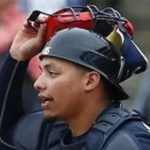 4. William Contreras, C
4. William Contreras, C
Age: 23 | Bats: R
2019: .255/.315/.354 | 98 wRC+ | 6 HR | 0 SB | 7.0% BB | 20.2% K (A+/AA)
2020: 60-man Player Pool
Acquired: International Amateur Free Agent – 2015
Prior Year Ranking: 7
Added to the 40-man roster the previous off-season and coming off a minor league year that saw him working on cleaning up his defensive game, Contreras looked liek he would be ticketed for a trip back to AA Mississippi, working on a possible late-season call-up, perhaps when the rosters expanded in September. One pandemic and illness to both major league catchers later, and Contreras was pressed into major league action, making his debut on Opening Day coming into the game behind the plate after starting catcher Alex Jackson was pinch hit for. Contreras would end up going 4-for-10 in four games (two as the starting catcher) before regular starters Travis d’Arnaud and Tyler Flowers recovered and Contreras was consigned back to Alternate Training Site. Contreras would get back to the majors, added to the Braves Wild Card roster, but he would not appear in the series, and would be dropped the rest of the playoffs in favor of more pitching.
Throughout spring training and the post-shutdown camp, Contreras showed significant adjustments at the plate from 2019. Overall his swing is “quieter”, with less moving parts prior to the swing, allowing for better bat control and allowing his bat speed to bring more power into each swing naturally. Defensively he took significant strides in 2019. In 2020, he showed athleticism behind the plate and appeared to work well with his pitchers. even if his pitch framing wasn’t quite where the Braves likely would want it to be.
The Braves at the time of this writing have not moved to bring in a veteran catcher or re-sign free agent Tyler Flowers; if this continues to be the status, Contreras will go into spring training with a strong case to be the second catcher in Atlanta, battling with Alex Jackson. Given that it was Contreras and not Jackson that was added to the Wild Card roster, the Braves possibly have given an indication about how they think that battle would go.
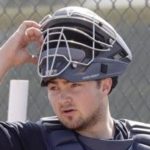 5. Shea Langeliers, C
5. Shea Langeliers, C
Age: 23 | Bats: R
2019: .255/.310/.343 | 92 wRC+ | 2 HR | 0 SB | 7.1% BB | 23.0% K (A)
2020: 60-man Player Pool
Acquired: Drafted, 1st Round – 2019
Prior Year Ranking: 6
Langeliers impressed Atlanta coaching staff during spring training with his advanced technique behind the plate and demonstrating better-than-expected contact and power. It was a foregone conclusion that he would be included in the 60-man player pool when baseball resumed after the pandemic shutdown, even through there was no chance of a promotion to the majors outside of a absolute emergency — which the Braves narrowly avoided when both starting catchers came down with COVID-19 symptoms but instead tested negative. At the Alternate Training Site, Langeliers was able to get more repetitions behind the plate with the creme of the crop of Braves pitching prospects, which can only help him going into 2021.
Langeliers is built like how a catcher would be diagramed in a technical manual on what catchers should look like — thick in the chest and legs, but athletic. He moves well behind the plate and also owns the strongest throwing arm of all Braves minor league catchers (and that’s saying something with canons like William Contreras and Alex Jackson around as well). At the plate, Langeliers has a line-drive oriented swing and looks to pull the ball early in the count, then take what the pitcher gives him if he falls behind. Langeliers can put the ball over the fence, but right now the bat path isn’t geared for high home run totals.
After a summer of facing the best pitchers that the Braves system offers, it seems likely Langeliers may skip the high-A level and jump straight to AA Mississippi. Already capable of major-league caliber defense, Langeliers looks on track to getting a share of major league action by 2022.
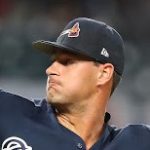 6. Kyle Muller, LHP
6. Kyle Muller, LHP
Age: 23
2019: 3.14 ERA | 3.75 FIP | 22 G, 22 GS | 111.2 IP | 5.48 BB/9 | 9.67 K/9 (AA)
2020: 60-man Player Pool
Acquired: Drafted, 2nd Round – 2016
Prior Year Ranking: 8
The 2016 draft was a windfall for Braves pitching, with Ian Anderson, Bryse Wilson, and Joey Wentz (since traded for Chris Martin) taken in the first four rounds along with Muller, all of them from the high school ranks. Of the four, Muller has had the most deliberate pace up the organizational ladder, spending all of 2017 in extended spring training and Danville as Anderson, Wentz, and Wilson dazzled in low-A Rome. The following season he finally made his Rome debut and showed re-worked mechanics that emphasized extension and control but a fastball that sat in the low-90s. This iteration allowed him to rise quickly, finishing the season at AA Mississippi along with Anderson, followed by a strong showing in the Arizona Fall League.
For the 2019 season, Muller changed again. Doubling down on weight training and spending time at the Driveline baseball clinic, Muller arrived with further modified mechanics. Muller now emphasized fastball velocity and a sharper break on his slider while still maintaining good extension to take advantage of his 6′-7″ height. Both walks and strikeouts skyrocketed. In 2020, reports out of the Alternate Training Site have his fastball touching 100 mph in games now and improved control. If true, Muller now has the potential to be a front-of-the-rotation type starter. If the control doesn’t come around, he should be able to be a shut-down reliever.
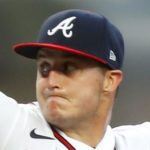 7. Tucker Davidson, LHP
7. Tucker Davidson, LHP
Age: 25
2019: 2.15 ERA | 3.17 FIP | 25 G, 25 GS | 129.2 IP | 3.75 BB/9 | 9.30 K/9 (AA/AAA)
2020: 60-man Player Pool
Acquired: Drafted, 19th Round — 2016
Prior Year Ranking: 11
Davidson came into spring training camp as reigning Organizational Pitcher of the Year after winning the AA Southern League ERA title and making his way to AAA Gwinnett. After an impressive spring training, it seemed only a matter of time before Davidson would be called up to make his major league debut in either a spot start or to get his feet wet out of the bullpen.
After the pandemic shutdown and the near-catastrophic failure of the Braves rotation early in the season, many wondered when Davidson would get his chance. Even as the team patchworked the rotation, Davidson still didn’t get the call until September 26, after the Braves had persevered and claimed their third straight NL East title. Apparently at the Alternate Training Site, coaches were working with Davidson to improve his delivery to take some of the stress off of his arm and allow him to go deeper into games. This seems to indicate that the Braves see Davidson ultimately as a starting pitcher. He has a mid-90s fastball and two above average breaking balls, so the repertoire is there. As his major league debut showed in a small capsule, he has the ability to get big leaguers out, but needs to fine tune his control.
Davidson will likely be ticketed to AAA Gwinnett to start the season, but should be on the 6th-starter carousel and looking for more.
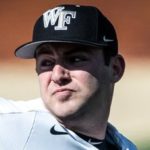 8. Jared Shuster, LHP
8. Jared Shuster, LHP
Age: 22
2020: 60-man Player Pool
Acquired: Drafted, 1st Round – 2020
Prior Year Ranking: N/A
While fans are still waiting for the official pro debut of Braves 2020 first-rounder Jared Shuster, the club got a good look at the former Wake Forest lefty at the Alternate Training Site, and that look apparently left a good impression. “Shuster has one of the better changeups in the system already,” Braves farm director Ben Sestanovich told MLB.com’s Jonathan Mayo in October, a bold statement considering that Ian Anderson was at that time dominating the NL playoffs thanks in large part to his change-up.
In addition to the change-piece, Shuster has a mid-90s fastball and a loopy curve — at least the last time anyone really saw him outside of the organization. He made himself a first-rounder by drastically sharpening his control in his junior season and in the Cape Cod league. Assuming he continued to develop his curve and his control doesn’t back up, there’s a possibility Shuster could make his pro debut in AA Mississippi, though high-A Rome is likely a safer bet.
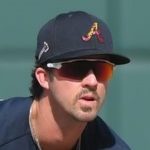 9. Braden Shewmake, SS
9. Braden Shewmake, SS
Age: 23 | Bats: L
2019: .300/.371/.425 | 133 wRC+ | 3 HR | 13 SB | 9.0% BB | 14.4% K (A/AA)
2020: 60-man Player pool
Acquired: Drafted, 1st Round – 2019
Prior Ranking: 10
A good 2019 pro debut showed that he had the defensive chops to be an everyday shortstop. A tough go in AA Mississippi to end 2019 and a listless spring training however opened space for doubt that he will be able to hit well enough at higher levels to make the kind of impact expected of a first-round pick.
Shewmake has a quick, even all-fields swing that is tough to defend against when he’s able to stay in front of the ball. Shewmake is a quick and smart baserunner. Tall and somewhat lanky, the Braves have been working with Shewmake to add muscle; if that works, Shewmake could regularly run into double-digit home runs thanks to his hit tool. Quick and athletic, Shewmake’s hands and instincts at shortstop were better than advertised in 2019, but he should also have enough arm for third base if needed there. The Braves may feel like Shewmake may still have something to prove at the AA level, but an Opening Day assignment at AAA Gwinnett may not be out of the question after having a full summer at the Alternate Training Site.
 10. Michael Harris, OF
10. Michael Harris, OF
Age: 20 | Bats: S
2019: .277/.344/.393 | 114 wRC+ | 2 HR | 8 SB | 8.5% BB | 19.8% K (Rk GCL/A)
2020: 60-man Player Pool
Acquired: Drafted, 3rd Round – 2019
Prior Ranking: 14
The Stockbridge, GA native was, until shortstop Vaughn Grissom joined him, the only teenager invited into the Braves’ 60-man player pool at the start of the season. Appearing in the exhibition games against the Miami Marlins before the start of the season, you could see why — despite facing much older and more experienced talent, Harris held his own with good at-bats. He also had filled out his body more after a strong pro debut with the GCL Braves and a few weeks being challenged at low-A Rome.
Harris has plus power and hit potential to go with a strong arm and good wheels. He has shown more than enough aptitude for centerfield for now. If my math is working, that adds up to five tools. What Harris needs now is game situation at-bats, and I suspect he will get them at high-A Rome to start 2021, though I would not put money on him staying there for long.
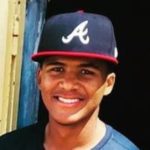 11. Ambioris Tavarez, SS
11. Ambioris Tavarez, SS
Age: 17 | Bats: R
Acquired: International Amateur Free Agent – 2021
Prior Year Ranking: N/A
It’s been over 4 years since Atlanta has been able to give an international amateur free agent a signing bonus of more than $300,000, and over 18 months since they’ve been able to give a bonus over $10,000. While still under sanctions during this signing period which cut the Braves available bonus pool in half, the team has decided to give almost all of it to Dominican shortstop prospect Ambioris Tavarez.
Tavarez is already a big kid at 6′-2″ and 175 pounds as of last April, with room for more muscle. What stands out about Tavarez is his excellent bat speed which gives him strong raw power and hit tools. While it’s possible he’ll grow out of the position, he shows a strong arm from shortstop. While I am tentative to place untested young talent so high on this list (I learned a lesson when I put Kevin Maitan at #6 on my initial prospect list back in 2016), video that I am seeing and reports that I am reading are very exciting. I would say that the Braves typically start their top young Latin American prospects in the GCL rather than the DSL, but the Braves haven’t had a top young Latin American prospect under the current regime, so it’s hard to say what is typical, but I would guess he will start his pro career stateside in North Port.
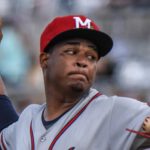 12. Jasseel De La Cruz, RHP
12. Jasseel De La Cruz, RHP
Age: 23
2019: 3.25 ERA | 3.55 FIP | 25 G, 24 GS | 133.0 IP | 3.32 BB/9 | 8.19 K/9 (A/A+/AA)
2020: 60-man Player Pool
Acquired: International Amateur Free Agent – 2015
Prior Ranking: 10
De La Cruz almost made his major league debut in 2020, getting recalled on September 15 and becoming the first Brave to be assigned uniform #69 on the active roster, but he didn’t get into a game. Still, it seems just a matter of time for the big right-hander, and he put on an impressive showing in both spring and summer camp after bouncing back from injuries in 2018 to climb two spots in the organizational ladder in 2019.
De La Cruz features a 4-seam fastball that typically sits in the mid-90s, touching 100 in short stints. It pairs well with an improved slider and change-up. In 2019 De La Cruz showed improved control for all of his pitches, elevating him not just up to AA Mississippi, but higher in most evaluations as well. De La Cruz even threw a no-hitter while passing through high-A Florida in 2019. De La Cruz is an intimidating presence on the mound and pitches with confidence. While his repertoire and mindset would also work in the bullpen — and given the Braves starting pitching depth, that may be where his immediate future with the club lies — for now the Braves seem content to keep working him as a starter. He likely would start in AAA in most organizations, but that starting rotation depth may push him back to AA Mississippi to start the season.
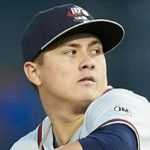 13. Victor Vodnik, RHP
13. Victor Vodnik, RHP
Age: 21
2019: 2.94 ERA | 2.79 FIP | 23 G, 3 GS | 67.1 IP | 3.21 BB/9 | 9.22 K/9 (A)
2020: 60-man Player Pool
Acquired: Drafted, 14th Round – 2018
Prior Year Ranking: 18
Vodnik was the youngest Braves pitcher at the Alternate Training Site this summer, which tells everyone what the Braves think of his arm. The biggest question for Vodnik is if his future is in a rotation or a bullpen. At least for now, according to Braves farm director Ben Sestanovich, the Braves are still looking at Vodnik as a starter. Talking to MLB.com’s Jonathan Mayo in October, Sestanovich indicated that “a lost year is hard for everybody, but these guys getting a prolonged period of time gave us some valuable development time. It’s three real pitches. It’s a four-seamer with big velocity, he was up to 98 last year and over the course of this time, we saw some strides with both the changeup and the slider. Six-foot righties are always in this world of ‘Can they start?’ But from a delivery and stuff standpoint, I think we feel he has the ingredients to start.”
Quite simply, the more innings Vodnik can pitch, the better off for his team. Vodnik was already punishing the low-A South Atlantic League in 2019 with his three-pitch mix with the slider ahead of the change-up. It’s likely blister issues in mid-season that robbed Vodnik his change to start in the second half of that season. If the Braves stay the course and keep Vodnik in the rotation, I suspect he’ll return to Rome in 2020 as both he and the team bump up a level. If the Braves change their mind and leave him in the bullpen however, Vodnik could make the double-jump to AA Mississippi.
14. Bryce Ball, 1B
Age: 22 | Bats: L
2019: .329/.395/.628 | 173 wRC+ | 17 HR | 0 SB | 9.9% BB | 19.0% K (Rk+, A)
2020: 60-man Player Pool
Acquired: Drafted, 24th Round – 2019
Prior Year Ranking: 21
The 6′-6″ monster that teammates have nicknamed “Drago” had the Atlanta coaching staff and media talking after reporting to spring training as a non-roster invitee and firing off moonshots in batting practice. It was enough for the team to put Ball on in their 60-man player pool where they reportedly worked extensively with him on his defense at first base, an area that the Dallas Baptist product was clearly uncomfortable with in his otherwise outstanding 2019 pro debut.
Ball has the top raw power tool in the Braves minor leagues, made more potent by good strike zone judgement. He’s also not an all-or-nothing slugger either, willing to go opposite field with the pitch or take a walk if offered. What Ball needs now is at-bats against higher level opposition. After a year at the Alternate Training Site, I suspect he will skip the high-A level and start 2021 in AA Mississippi.
15. Alex Jackson, C
Age: 25 | Bats: R
2019: .229/.313/533 | 109 wRC+ | 28 HR | 1 SB | 5.8% BB | 34.2% K (AAA)
2020: 60-man Player Pool
Acquired: Trade w/Seattle Mariners – 2016
Prior Ranking: 16
The scouting report hasn’t really changed for “AJax”. Big power. Strong defense. Serious contact issues that will prevent him from reaching his ceiling of starting catcher in the major leagues. When illness sidelined Travis d’Arnaud and Tyler Flowers for the first five games of the season, Jackson started three of the five games. The good news is that he finally got his first major league hit in the third game, a ringing double off Tampa Bay’s Yonny Chirinos that showed Braves fans just how hard Jackson can make contact when he makes contact. Still, when the Braves decided to add a third catcher for the opening round of the playoffs, it was William Contreras that got the nod.
Unless the Braves add a veteran catcher before the season, Jackson will go into spring training to battle Contreras for a chance to be the second catcher for Atlanta behind d’Arnaud. Defensively he’s ahead of Contreras which may give him the leg up in the battle, but continued advancement in that area from Contreras or lack of improvement in Jackson’s ability to put bat on ball would see him quickly return to AAA Gwinnett.
 16. Patrick Weigel, RHP
16. Patrick Weigel, RHP
Age: 26
2019: 2.73 ERA | 5.14 FIP | 28 G, 18 GS | 79.0 IP | 4.67 BB/9 | 8.09 K/9 (AA/AAA)
2020: 60-man Player Pool
Acquired: Drafted, 7th Round – 2015
Prior Ranking: 12
Now two and a half seasons removed from TJS, Weigel is still caught in a bit of no-man’s-land between AAA and the majors, and starting and relieving. At least the later distinction may be clearing up — there was no indication last spring or in the summer that Weigel was being looked at as a major league starter by the Braves. Weigel did make his major league debut in 2020 after three times being recalled to Atlanta in 2019 without entering a game.
If he is a reliever going forward, Weigel has the tools to be successful there, possibly as a high-leverage back-end guy. When healthy, he has a fastball that reaches the high 90s in short stints and a tight curveball that can get swing-and-miss. He also has a solid change-up, and it looked like he was in the process of transforming his slider into a cutter in 2020. In his debut, with his adrenaline pumping, his mechanics got out of sorts and he overcooked most of his pitches. He no doubt learned a lot about keeping his poise, and I would expect considerable improvement when his next opportunity arises.
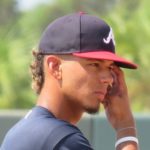 17. Vaughn Grissom, SS
17. Vaughn Grissom, SS
Age: 20 | Bats: R
2019: .288/.361/.400 | 120 wRC+ | 3 HR | 3 SB | 8.7% BB | 14.7% K (Rk GCL)
2020: 60-man Player Pool
Acquired: Drafted, 11th Round – 2019
Prior Ranking: 20
Grissom and Michael Harris were the two teenagers invited to the Braves summer 60-man player pool, indicating their standing within the organization. Sestanovich said of Grissom, “He continued to impress with very mature at-bats. He has a very good sense of the strike zone for a young kid. Early on, looks like he has the knack to make contact and find the barrel.”
What is uncertain is Grissom’s future position. He played exclusively at shortstop in 2019 for the GCL Braves, but the Braves tried him at third base at the Alternate Training Site, and Sestanovich noted his “versatility”. I would expect Grissom to continue to get looks at shortstop in 2021, but ultimately as he fills out his 6′-3″ frame he seems likely to settle at third base. His arm and hands should be up to the challenge.
18. Trey Harris, OF
Age: 25 | Bats: R
2019: .323/.389/.498 | 159 wRC+ | 14 HR | 8 SB | 6.9% BB | 17.3% K (A/A+/AA)
Acquired: Drafted, 32nd Round – 2018
Prior Ranking: 13
All Harris has done since joining the Braves organization is hit. He’s not going to be accused of having the prettiest swing in the organization, but his quick, violent stroke combined with a smart approach at the plate allows him to pepper the field with line drives and occasionally pull the ball over the fence. The pandemic shutdown however did Harris no favors, arresting his ascent through the organization, and there will still be questions on how his approach will fare against more advanced pitching.
Harris can play either outfield corner and hold his own. He has the quickness to offset the occasional poor route, and that same quickness helps makes him a strong baserunner along with good instincts. As a 32nd-rounder and a student of the game, Harris is someone who is easy to pull for, and it doesn’t take much imagination to see him make a career as a major league 4th or 5th outfielder. A good spring could see him advance up to AAA Gwinnett to start the season.
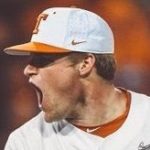 19. Bryce Elder, RHP
19. Bryce Elder, RHP
Age: 21
2020: Instructional League invitee
Acquired: Drafted, 5th Round – 2020
Prior Ranking: N/A
The Braves were able to slide Elder down the draft to take him overslot in the 5th round. A workhorse for the University of Texas, Elder exhibits the profile to throw strikes and induce groundballs that the Braves have targeted in recent drafts and signings. Elder has an advanced arsenal that includes an above average two-seam fastball and slider with strong horizontal break that can get whiffs and weak contact. He complements it with a developing curve and change-up.
Elder has repeatable, uncomplicated mechanics that allow him to pitch effectively without maximum effort. A relatively complete pitcher already, I would expect Elder to make his debut at high-A Rome, and he should have some early success that moves him up quickly.
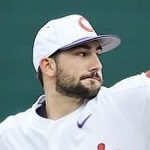 20. Spencer Strider, RHP
20. Spencer Strider, RHP
Age: 22
2020: 60-man Player Pool
Acquired: Drafted, 4th Round – 2020
Prior Year Ranking: N/A
Strider came back from TJS his sophomore year at Clemson with an uptick in velocity and explosiveness on his fastball, enough so that the Braves grabbed him in the 4th round of 2020’s 5-round draft. Working with Braves coaches at the alternate training site during the summer, Strider started approaching 100 on the fastball.
A starter in college, Strider likely profiles as a reliever in the major leagues, but the Braves seem likely to put him in a rotation to start his pro career to get him more innings. In addition to the fastball, Strider has a solid curveball that he can vary the shape on (on purpose or not I haven’t seen enough video to be sure) and a developing change-up. He will likely start the season in high-A Rome, but could drop to low-A Augusta because of organizational pitching depth.
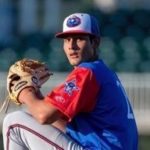 21. Freddy Tarnok, RHP
21. Freddy Tarnok, RHP
Age: 22
2019: 4.87 ERA | 3.72 FIP | 19 G, 19 GS | 98.0 IP | 3.31 BB/9 | 7.53 K/9 (A+)
Acquired: Drafted, 3rd Round – 2017
Prior Ranking: 23
Tarnok looked to have a bit of a breakthrough in the second half of 2019 as a starter for high-A Florida; the pandemic shutdown didn’t do him any favors in particular. While he was not at the Alternate Training Site this summer, video did surface of him hitting 99 with the fastball on a max effort throw. While that likely won’t happen on the field if he continues his career as a starter, it was encouraging to see him working hard over the shutdown.
Tarnok has worked on simplifying his delivery in order to improve his command. He will also need to keep developing his secondaries, getting more bite on his curve and more deception on his change-up. The later has a chance to be a potential true weapon if he can mirror the arm speed of his fastball and get more velocity separation. Assuming the Braves elect to keep Tarnok in a rotation, he could return back to the high-A level to demonstrate mastery. His repertoire and command do indicate a high likelihood of a relief role at higher levels however, and if the Braves decide to place him in that role he could begin at AA Mississippi.
22. Nolan Kingham, RHP
Age: 23
2019: 3.92 ERA | 2.93 FIP | 27 G, 27 GS | 165.1 IP | 1.96 BB/9 | 6.31 K/9 (A/A+/AA)
Acquired: Drafted, 12th Round – 2018
Prior Year Ranking: 24
Perhaps it’s not a coincidence that the Braves were eager to draft the University of Texas’s Bryce Elder in 2020. After all, they had a version of him already performing well in their system in 2018 draft pick from Texas, Nolan Kingham. Like Elder, Kingham has an uncomplicated delivery to go with a body that should be able to deliver lots of innings. He has a four pitch mix, with his best pitches a two-seam fastball with good tailing action that sits in the low 90s and a change-up with similar action. He also has a 4-seam fastball that he uses to elevate to change eye level that can run up into the mid-90s, and a slider than has swing-and-miss potential. Mostly however Kingham is content to pound the lower part of the zone and allow hitters to get themselves out by putting the ball on the ground.
Kingham advanced to AA Mississippi in 2019 and had some success there. Thanks to Atlanta’s enviable high-level minor league pitching depth it seems likely he’ll return there to start 2021.
23. Tyler Owens, RHP
Age: 20
4.28 ERA | 3.99 FIP | 10 G, 9 GS | 27.1 IP | 3.95 BB/9 | 10.54 K/9 (Rk GCL/Rk+)
2020: Instructional League invitee
Acquired: Drafted, 13th Round – 2019
Prior Year Ranking: 27
The first of three high-ceiling prep pitchers taken by the Braves in Day Three of the 2019 draft (along with Jared Johnson and Joey Estes), Owens got the largest signing bonus of any Day Three draftee and the highest bonus of any prep draftee after outfielder Stephen Paolini. Owens was also the only prep draftee to be promoted in 2019, moving up from the GCL to Danville after two appearances.
In both stops, Owens showcased a mid-90s fastball and a developing slider and change-up. The fastball can touch 99 in short stints. Owens is only 5′-10″ and could add a couple inches of height, but even if not he still has a solid trunk and is able to get velocity through utilizing his lower half well. There weren’t a lot of good swings against Owens, even against older competition in the Appalachian League, and improvement in repeating his release point should help his command. Owens seems likely to open up the 2021 campaign in low-A Augusta, and the Braves could elect to start him in the bullpen to manage his innings, as they did with Freddy Tarnok in 2018 and Victor Vodink in 2019.
 24. Mahki Backstrom, 1B
24. Mahki Backstrom, 1B
Age: 19 | Bats: L
2019: .300/.402/.457 | 149 wRC+ | 2 HR | 1 SB | 14.6% BB | 32.9% K (Rk GCL)
2020: Instructional League invitee
Acquired: Drafted, 18th Round – 2019
Prior Year Ranking: 28
Thanks to his fastidious documenting of his off-season workouts on social media (thank you, younger generation), fans have been able to watch Mahki Backstrom’s continued physical maturation. Already possessing an impressive physicality when the Braves selected him as a 17-year-old high schooler in 2019, Backstrom looks to have added about 10 pounds of lean muscle to his frame. Just as impressive is his batting practice swing, which has also matured and is one of the smoother lefty swings in the organization. What no one has seen yet is how this will carry over into more advanced competition, and hopefully that’s remedied by May when he takes the field with the Augusta Greenjackets.
But don’t take it from me, here’s Ben Sestanovich: “He’s very strong. He’s a tremendous worker who has worked a ton on his agility and his footwork, making strides on his defense. The potential for a power, left-handed bat is intriguing.”
25. Greyson Jenista, OF/1B
Age: 24 | Bats: L
2019: .233/.318/.349 | 99 wRC+ | 9 HR | 3 SB | 11.1% BB | 29.8% K (A+/AA)
2020: .106/.189/.234 | 1 HR | 1 SB | 11.3% BB | 47.1% K (Constellation Energy League)
Acquired: Drafted, 2nd Round – 2018
Prior Year Ranking: 17
The top pick for the Braves in 2018 (when they were unable to come to terms with 1st-round pick Carter Stewart), Jenista was in the midst of a swing change that was just starting to bear fruit for him towards the end of the 2019 season. He was sent to the Arizona Fall League to get more reps in, but an injury knocked him out of the line-up after only 12 games. Jenista then got an invitation to big league spring training where he looked comfortable at the plate and even hit two home runs.
Then of course the shutdown happened. Jenista was able to pick up a handful of at-bats in a Houston-area independent league for prospects and former major leaguers trying to stay loose. That all said, it was a lost season in a particularly inopportune time for Jenista’s development. When he’s on, Jenista has impressive power and strike-zone judgement. When he’s off he’s late on too many pitches and grounds out too much. Defensively he plays a solid corner outfield, and can also play first base when needed, as he did in the AFL.
 26. Jeremy Walker, RHP
26. Jeremy Walker, RHP
Age: 24
2019: 2.78 ERA | 2.42 FIP | 38 G, 2 GS | 90.2 IP | 1.50 BB/9 | 8.78 K/9 (AA/AAA/MLB)
2020: Disabled list
Acquired: Drafted, 5th Round – 2016
Prior Year Ranking: 26
Walker converted to the bullpen in 2019 after working as a starter since joining the organization, and he took to the role like a duck to water. Mostly working piggyback assignments with Patrick Weigel in AA Mississippi, Walker advanced first to Gwinnett, then Atlanta where he appeared in 6 games in August and September and didn’t look out of place. Expected to make a push for an Opening Day bullpen assignment the following spring, Walker instead was felled by a right shoulder impingement which kept him out of spring and summer.
Fellow right-hander Jacob Webb faced a similar injury and took about 11 months to recover, so there is no guarantee that Walker will be 100% at the start of spring training for 2021. When healthy, Walker is a strike-thrower who likes to get hitters to beat themselves with weak contact. That said, moving to shorter stints has pushed his fastball velocity into the mid-90s, giving him better separation from his curveball and slider and giving him more swing-and-miss opportunities. Once Walker shows his health is all the way back, he should once again challenge for bullpen innings in Atlanta.
27. Daysbel Hernandez, RHP
Age: 24
2019: 1.71 ERA | 2.68 FIP | 35 G, 0 GS | 52.2 IP | 3.93 BB/9 | 11.96 K/9 (A+)
2020: Instructional League invitee
Acquired: International Free Agent – 2017
Prior Year Ranking: 41
The lost season absolutely did no favors for Cuban righty Hernandez, who was riding high after a dominating season as a high-leverage reliever for high-A Florida. However, Hernandez has pitched in (as of this writing) 7 games for Caneros de los Mochis of the Mexican Winter League and would seem to be in good shape for this spring.
Hernandez has a mid-to-high-90s fastball to go along with a hard slider that’s his bread-and-butter out pitch. In Mexico, Hernandez has been working the fastball only, honing his command for the next level. If Hernandez has similar success in Mississippi in 2021 as he did in Florida in 2019, don’t expect him to stick there for long.
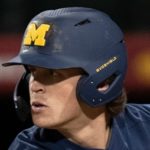 28. Jesse Franklin, OF
28. Jesse Franklin, OF
Age: 22 | Bats: L
2020: 60-man Player Pool
Acquired: Drafted, 3rd Round – 2020
Prior Ranking: N/A
Franklin was an underslot 3rd-round pick thanks to missing the entire 2020 collegiate season after suffering a broken collarbone in a skiing accident. This follows an injury-plagued 2019 season that saw his production at the University of Michigan suffer from a splendid freshman campaign. Braves player development has a project with his swing, which is quite long though he has a feel for the barrel head.
Franklin is also a good baserunner and he will be given the opportunity to play centerfield. Franklin gets high marks on make-up and leadership, and Braves officials praised his work ethic at the Alternate Training Site and in instructionals. He seems likely to start the season in low-A Augusta.
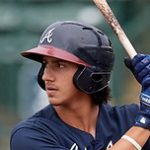 29. Stephen Paolini, OF
29. Stephen Paolini, OF
Age: 20 | Bats: L
2019: .192/.315/.242 | 73 wRC+ | 0 HR | 2 SB | 15.4% BB | 25.9% K (Rk GCL)
2020: Instructional invite
Acquired: Drafted, 5th Round – 2019
Prior Year Ranking: 46
Somewhat overwhelmed by his first exposure to the pros in 2019, the New England native has been working on remaking his swing and filling out his body. Reports from the instructional workouts this October have been very positive.
What Paolini needs now is exposure to pitching and game situations. He’s a strong potential 5-tool player if his swing changes and improved pitch recognition allow him to drive the ball more consistantly, and there’s a strong potential that by the end of 2020 he could make this #35 ranking look ridiculously conservative. Paolini is a good bet to begin the season with low-A Augusta as their centerfielder.
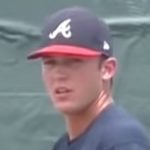 30. William Woods, RHP
30. William Woods, RHP
Age: 22
2019: 3.35 ERA | 4.06 FIP | 20 G, 7 GS | 51.0 IP | 5.12 BB/9 | 10.24 K/9 (A)
2020: 60-man Player Pool
Acquired: Drafted, 23rd Round – 2018
Prior Year Ranking: N/A
Woods is the rare prospect who’s stock has climbed during the 2020. Woods had a strong first full-season campaign with Rome in 2019, working first out of the bullpen before moving to his preferred starting role. He thrived in the rotation and seemed likely to resume that role in 2020 at the high-A level. Instead came the pandemic. Woods took to social media, and a September Twitter video showed him hitting 99 on the gun from an outside mound and not long afterwards the Braves found room for him in the 60-man player pool.
With Rome, Woods showed a consistent mid-90s 4-seam fastball with solid command. The command wasn’t there however for his secondaries, which include a a change-up and curve, both of which need to improve to succeed at the next level. After his time during the season at the Alternate Training Site, Woods continued to work with Atlanta’s best player development coaches during instructionals and will likely finally make his high-A debut this spring.
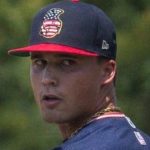 31. Kasey Kalich, RHP
31. Kasey Kalich, RHP
Age: 22
2019: 1.25 ERA | 2.80 FIP | 14 G, 0 GS | 21.1 IP | 4.57 BB/9 | 9.97 K/9 (Rk GCL/A)
Acquired: Drafted, 4th Round – 2019
Prior Ranking: 25
Kalich is one of the few on this list that did not lose too much development in 2020. Kalich suffered a broken wrist in an off-season weightlifting incident, and likely wouldn’t have pitched until late June at the earliest. Kalich, the first pitcher taken by the Braves in the 2019 draft, was a closer for Texas A&M and may be the closest the Braves have to a “closer prospect”. has a prototypical pitcher’s body at 6′-3″ and 220 pounds. He throws a four-seam fastball that tends to ride high in the zone and tops out in the high ’90s, but his main strikeout pitch is a hard mid-80s slider that he can cut away from left-handed batters. Kalich is also developing a straight change and curveball.
The one knock with Kalich’s pro debut was his high walk count. Kalich seems likely to start in high-A Rome, but if can show consistency and improved control, he’s the type of pitcher that could make an AJ Minter-style rapid ascent.
 32. Justin Dean, OF
32. Justin Dean, OF
Age: 24 | Bats: R
2019: .284/.386/.431 | 141 wRC+ | 9 HR | 47 SB | 12.3% BB | 22.9% K (A)
Acquired: Drafted, 17th Round – 2018
Prior Year Ranking: 19
Dean had a superb season with low-A Rome in 2019 and only a mid-season hand injury likely kept him from a promotion to high-A before the end of the season. Now a year older after missing 2020 like all other minor leaguers, Dean will have to re-establish himself in spring training.
Dean has the make-up and ability to be a plus hitter, centerfield defender, and base stealer. What he wasn’t able to work on last season were elements that, if improved, could put him on a major league path, namely improving his pitch recognition and bat path, which caused too many strikeouts and pop-ups in 2019, respectively. There is a glut of outfielders at the A-ball level, so the Braves may push him to AA Mississippi to start the season if he demonstrates he can handle it this spring.
 33. Riley Unroe, SS/3B
33. Riley Unroe, SS/3B
Age: 25 | Bats: S
2019: .281/.361/.403 | 124 wRC+ | 9 HR | 14 SB | 10.3% BB | 20.7% K (A+/AA/AAA)
2020: Spring training invite
Acquired: Rule 5 draft (Angels) — 2018
Prior Year Ranking: N/A
One of the first things the Braves did at the start of this offseason was re-sign Unroe, who was eligible for minor league free agency. The organization is clearly impressed with the multi-positional former 2nd-rounder. He plays all three infield skill positions well and is a sound hitter, especially from the left side of the plate, looking to pull line-drives into the corner for extra bases.
Unroe has gone to Australia this winter (summer?) to get some game action in before spring training. Expect Unroe to be invited back to big league camp and be given a long look as a potential infield call-up during the season if need arises.
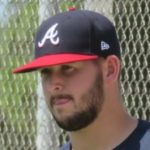 34. Jared Johnson, RHP
34. Jared Johnson, RHP
Age: 20
2019: 3.52 ERA | 2.72 FIP | 6 G, 6 GS | 15.1 IP | 2.35 BB/9 | 7.04 K/9 (Rk GCL)
2020: Instructional League invitee
Prior Year Ranking: 50
Johnson had zero recruiting buzz pitching at tiny Smithville High School in rural eastern Mississippi, but he got noticed his senior year when he started throwing into the high-90s in games. Within a few weeks he was featured in Baseball America and the word was out. The Braves ended up snagging him in the 14th round of the draft and signing him for $100,000 over slot to get him to forgo his Mississippi State commitment.
Johnson has worked hard to make himself a prospect, bringing mid-90s velocity into his starts to go along with a developing hard slider. With a 6’2″, 225 pound frame, Johnson has the physical attributes to be a workhorse pitcher, either in a rotation if he can develop a third pitch or in a bullpen if not.
35. Ricky DeVito, RHP
Age: 22
2019: 3.44 ERA | 4.43 FIP | 43 G, 8 GS | 57.0 IP | 3.93 BB/9 | 8.59 K/9 (Rk+/A)
2020: Instructional invite
Acquired: Drafted, 8th Round – 2019
Prior Year Ranking: 32
The Seton Hall product had a solid pro debut in 2019 pitching for Danville and Rome. A relatively polished pitcher coming into the organization, with three mid-grade pitches in his arsenal, DeVito impressed with his athleticism on the mound and a somewhat deceptive delivery. If DeVito can command his pitches better by maintaining a more consistent release point he could become a sneaky-good starting pitching prospect. If not, expect him to transition to the bullpen, where his low-90s fastball can gear up to a mid-90s fastball and provide more separation for his change-up.
DeVito is relatively young for being drafted as a college junior, so he has some time before that kind of decision needs to be made. I would expect him to start 2020 in the high-A Rome starting rotation, though he could start back in low-A if the competition for spots in Rome is strong.
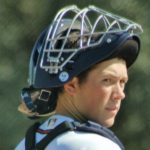 36. Logan Brown, C
36. Logan Brown, C
Age: 24 | Bats: L
2019: .272/.313/.334 | 92 wRC+ | 1 HR | 5 SB | 4.4% BB | 21.3% K (A/A+)
2020: 60-Man Player Pool
Acquired: Drafted, 35th Round – 2018
Prior Year Ranking: 30
As the son of former major league catcher Kevin Brown, it probably shouldn’t come as a surprise that Logan is one of the more defensively sound catchers in the organization, and it wasn’t too much of a surprise that he was selected by the Braves for this summer’s 60-man player pool, even though his chances for an actual call-up were negligible. After all, someone had to catch all those pitching prospects at the Alternate Training Site during the dog days of the minor league shutdown.
The extra work no doubt helped Brown’s development, both behind and at the plate. In his first full season of pro ball in 2019, Brown showed himself to be a solid, if unspectacular hitter, mostly looking to work up the middle and get on base. We’ll have to see if the Braves helped Brown possibly tap into more of his power or at lease elevate the ball a little more so that some of the sharp grounders Brown hit in 2019 could become sharp line drives in 2021. He will likely be challenged with a A Mississippi assignment.
37. CJ Alexander, 1B/3B
Age: 24 | Bats: L
2019: .117/.245/.180 | 33 wRC+ | 2 HR | 0 SB | 14.5% BB | 28.3% K (A+/AA)
Acquired: Drafted, 20th Round – 2018
Prior Year Ranking: 22
Of all the Braves prospects, it’s hard to think of one whose stock was hurt more by the shutdown than Alexander’s. After taking the 2018 season by storm after being drafted, hitting a combined .352/.429/.495 in 52 games for the GCL Braves, Danville, and high-A Florida, Alexander received a non-roster major league invitation to spring training in 2019. Unfortunately he hurt his elbow before the season, and when camp broke he elected to try to play through the injury, moving over to first base to ease the pain. It didn’t work, and after two and a half weeks, Alexander had arthroscopic surgery to repair the damage. When he returned in August, he showed to be rusty, and his season was cut short when he flipped over a railing pursuing a foul ball, injuring his wrist.
A fresh start in 2020 would be just what the doctor ordered, but nobody’s plans survived for long. What Alexander has going for him is a 6′-5″, 215 pound build and a swing that could put that frame to good use with a combination of line drives and over-the-fence power when everything is working right. Also working for him is the relative lack of depth at the third base position, so he should have some time to figure it out. While his hit tool likely isn’t strong enough to make those 2018 numbers happen at higher levels and over a longer stretch of games, a healthy Alexander should be able to overcome his disasterous 2019-20.
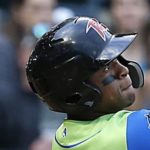 38. Jalen Miller, 2B
38. Jalen Miller, 2B
Age: 24 | Bats: R
2019: .216/.287/.332 | 83 wRC+ | 11 HR | 27 SB | 8.9% BB | 19.3% K (AA Richmond)
Acquired: Rule 5 draft (Giants) — 2020
Prior Year Ranking: N/A
Miller secured a $1.1 million signing bonus from the San Francisco Giants after being drafted in the 3rd round in 2015 out of Riverwood Charter High School in Sandy Springs, GA and was considered by Baseball America at one point as a the #16 prospect in the Giants system.
Pitch recognition however has been a bugaboo in his pro development. Despite quick hands and a fast swing, Miller gets fooled too often and only once in his minor league career — in 2018 when he repeated the high-A level at San Jose — has he put up above league average offensive performance. His bat speed helps generate power, and he’s capable of double-digit home runs. Drafted as a shortstop out of high school, an average arm had the Giants move him over to second base, but he shows good range and instincts for the position. He’s a also a strong baserunner and base-stealer.
It’s unusual to get a player of this kind of pedigree in the minor league portion of the Rule 5 draft, and the Braves will hope that coming to a new system will help unlock his offensive potential. Given the overall lack of minor league middle infield depth in the Braves system but entrenched major league infielders, there is opportunity for Miller to make progress without the burden of his high bonus expectations and the talent to make his escape from the Giants organization a potential windfall for the Braves.
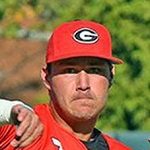 39. Cam Shepherd, SS
39. Cam Shepherd, SS
Age: 23 | Bats: R
2020: Instructional invite
Acquired: Minor League Amateur Free Agent – 2020
Prior Year Ranking: N/A
Ranked as the top 2020 undrafted college senior by Baseball America, the Braves may have had a hometown advantage in signing the Suwanee native and University of Georgia shortstop. Shepherd was the Division 1 Gold Glove winner at the position in 2019. In his abbreviated 2020 senior season, Shepherd hit .268/.372/.493, the highest OBP mark of his collegiate career.
Shepherd is a glove-first shortstop and comes into the organization as perhaps the most polished infielder in the organization. Shepherd has soft hands and good instincts, and marries that with an above-average arm to help make up for average range. This lack of range may eventually push Shepherd to second or third base as he moves up the ladder, but for now he will likely easily be able to hold down a solid shortstop. At the plate, Shepherd looks to go with pitches and line them through or past the infield, but has not demonstrated significant in-game power. Shepherd also has a strong clubhouse reputation and will likely be looked at as a leader on teams where most of the position players will be several years younger than him.
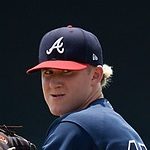 40. Joey Estes, RHP
40. Joey Estes, RHP
Age: 19
2019: 8.10 ERA | 4.01 FIP | 5 G, 5 GS | 10.0 IP | 6.30 BB/9 | 7.20 K/9 (Rk GCL)
2020: Instructional invite
Acquired: Drafted, 16th Round – 2019
Prior Year Ranking: N/A
The third of three interesting high school starting pitchers on Day 3 of the 2019 draft, Estes got a taste of pro ball at age 17 in the GCL. The results were predictably rough, but he demonstrated four pitches that have the potential to keep him as a starting pitcher as a climbs the ladder.
Estes has a mid-90s fastball when he wants it but usually sits 90-92 mph with an improving slider. He also has a change and curve in lower levels of development, at least as of the end of 2019. Being of such a tender age, the shutdown probably had the least amount of impact for him as far as draft stock; in fact he didn’t quite make our top 50 last season. Now he will go into 2021 fighting to start the season on the low-A August staff.
 41. Hayden Deal, LHP
41. Hayden Deal, LHP
Age: 26
2019: 3.24 ERA | 3.23 FIP | 23 G, 22 GS | 119.1 IP | 2.41 BB/9 | 7.47 K/9 (A+)
Acquired: Minor League Amateur Free Agent – 2017
Prior Year Ranking: 34
Like many prospects in their mid-20s, the shutdown couldn’t have come at a worse time for Deal. In his first season as a starting pitcher, Deal was high-A Florida’s best starting pitcher through the first half of the season, building off an eye-opening turn in the bullpen for Rome in 2018. While Deal ran out of gas in the second half, he seemed to be well-positioned to advance to the AA level as either a starter or reliever.
Fast-forward one lost season later, and Deal is in a pool of Braves pitchers in their mid-20s that haven’t made their AA debuts yet in an organization that added three high-profile college pitchers in the shortened draft. Deal will need to demonstrate that he hasn’t lost a step this spring quickly to make sure he carves himself a slice of innings. Deal is a command-over-stuff pitcher that uses a good sinking 2-seam fastball and a splendid cutter to pitch effectively to both sides of the plate and generate ground balls.
 42. Brooks Wilson, RHP
42. Brooks Wilson, RHP
Age: 25
2019: 2.47 ERA | 2.86 FIP | 24 G, 11 GS | 87.1 IP | 2.58 BB/9 | 7.52 K/9 (A+)
Acquired: Drafted, 7th Round – 2018
Prior Year Ranking: 38
Wilson is also one of the group of prospects in their mid-20s and were denied an opportunity to work their way out of A-ball in 2020 by the COVID-19 shutdown. A senior-sign out of Stetson University, Wilson opened eyes in 2019 after being pressed into starting duty for high-A Florida, pitching to a 2.60 ERA in 62.1 IP and holding batters to a .223/.276/.313 batting line.
Wilson uses a split-finger fastball and a strong curveball to to induce groundballs. He will compete with a now crowded group of pitchers, which now include 2020 draftees Jared Shuster, Bryce Elder, and Spencer Strider, for innings at AA Mississippi.
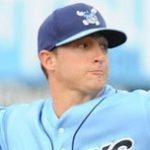 43. AJ Puckett, RHP
43. AJ Puckett, RHP
Age: 25
Acquired: Rule 5 draft (White Sox) — 2020
Prior Year Ranking: N/A
Puckett is a 2nd-round draft pick by Kansas City in the 2016 draft out of Pepperdine University; he was traded to the White Sox at the 2017 deadline in a deal for veteran outfielder Melky Cabrera. He went into spring 2018 as Chicago’s #15 prospect in what was a stacked minor league organization and looking forward to opening the season at AA Birmingham. A balky elbow however landed him on the IL before the season started however. Puckett and the organization tried to nurse the elbow through a non-surgical rehab, but he was not able to take the mound in a game for the entire season. When the elbow worsened the following spring the decision was made to undergo UCL transplant surgery, and Puckett missed the 2019 season as well. And then of course, 2020 was a thing that happened.
The Braves plucked Puckett out of the White Sox system in the minor league portion of the Rule 5 draft, so they have a virtually free look at what Puckett has left after not pitching competitively for three seasons. Before the elbow issues, Puckett showed a low-90s fastball with solid movement, a solid 12-6 curveball, and a change-up that was developing into a primary weapon. The Braves have some success at reclaiming other teams’ prospect who have gone through TJS, most notably 2020 Atlanta staff ace Max Fried.
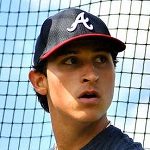 44. Antonio Barranca, C
44. Antonio Barranca, C
Age: 19 | Bats: R
2020: Instructional invite
Acquired: Minor League Amateur Free Agent – 2020
Prior Year Ranking: N/A
The 5-round draft wasn’t long enough for Calvert Hall College High School (MD) star Barranca to hear his name called, but that didn’t let him slow him down from starting his pro baseball career, signing as a rare prep non-drafted free agent. The son of former major leaguer German Barranca, Antonio played catcher and all four corner positions in high school, but the Braves will keep him firmly behind the plate after he started posting sub-2 pop times in showcase workouts. Barranca is large-framed at 6′-2″, 210 pounds and will need to work to maintain the flexibility to stay behind the plate, but the Braves have shown some aptitude with Alex Jackson in helping a player with a similar body become a defensive standout. At the plate Barranca has potential plus power and has shown good barrel control.
Barranca was one of only two catchers invited to Gwinnett for instructionals, so Barranca got a crash course in familiarizing himself with the system’s lower-level pitchers. Recently the Braves haven’t hesitated in putting young catchers in low-A, though results have been mixed. Barranca seems more likely to start the summer in extended spring training and wait for an opportunity to move up to Augusta later in the season.
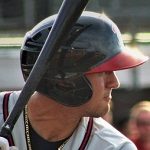 45. Beau Philip, SS
45. Beau Philip, SS
Age: 22 | Bats: R
2019: .193/.297/.280 | 69 wRC+ | 4 HR | 5 SB | 10.9% BB% | 21.3% K (Rk Danville)
2020: Instructional invite
Acquired: Drafted, 2nd Round – 2019
Prior Year Ranking: 36
Philip had a disappointing offensive start to his pro career in 2019 with Danville, but demonstrated the ability to hit the ball sharply and was better than advertised when drafted in the field. The Oregon State product was still recovering from a hamstring strain, so he wasn’t able to demonstrate the wheels that let him steal 30 bases for San Joaquin Delta College in 2018.
Philip is a line-drive, pull hitter when he’s going well, looking to use his legs to get doubles. He shows good strike-zone judgement but needs to improve his pitch recognition. In the field he shows good range and an excellent arm, but need more experience to improve his first step. He has all the tools necessary to be an above-average shortstop. Philip will likely start out either at Augusta or Rome for 2020, and more playing time and better health should make it clear if the Braves spent their 2019 2nd-round pick well.
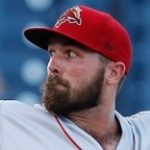 46. Phil Pfeifer, LHP
46. Phil Pfeifer, LHP
Age: 28
2019: 2.97 ERA | 2.93 FIP | 30 G, 18 GS | 133.1 IP | 2.84 BB/9 | 10.73 K/9 (A+/AA/AAA)
2020: 40-man roster
Acquired: Trade w/Los Angeles Dodgers – 2016
Prior Year Ranking: 37
After a breakthrough 2019 season prompted the Braves to place him on the 40-man roster, followed by 7 spring training appearances where he only gave up 1 run while striking out 10 and earning a save, it looked like Pfeifer had a good shot to make his major league debut in 2020 if not make the Opening Day roster outright. But as most everyone discovered this year, things can go pear-shaped quickly and Pfeifer instead starting experiencing elbow soreness just before the shutdown. When the Braves gathered again in July to prepare for the abbreviated 2020 season, Pfeifer continued to experience soreness, and was placed on the 45-man IL before the season started for a left elbow bone contusion, which would keep him out for the season.
When healthy, Pfeifer sits in the low 90s with a 4-seam fastball, bumping up the mid-90s as a reliever. His strikeout pitch is a sharp curve. He has a slider and change-up that he works in as a starter, but his major league future is going to be built out of the bullpen and that 4-seam/curve combo. The Atlanta bullpen is full to the seams with good left-handed pitchers, so even if he comes back healthy Pfeifer will likely need to wait for an injury to finally get the call.
47. Cody Milligan, 2B
Age: 22 | Bats: L
2019: .252/.384/.299 | 104 wRC+ | 1 HR | 12 SB | 16.7% BB | 20.5% K (Rk Danville)
2020: Instructional invite
Acquired: Drafted, 9th Round – 2019
Prior Year Ranking: N/A
Milligan is a high-motor lead-off type who converted from playing catcher in college. He is raw in the field, but athletic enough that second base could be a fit for him going forward. He was a catcher mostly due to his strong throwing arm. Plate discipline was advanced for the advanced-rookie level, and he should be more aggressive at the plate when pitchers are more likely to pitch near the strike zone. Milligan has a gap-to-gap approach at the plate and above average speed to make that work for him. Milligan comes from a baseball family and has natural leadership skills.
An instructional league invite shows he’s on the organization radar, and he’s young enough — drafted in 2019 as a community college sophomore — that the lost 2020 season shouldn’t set him back too much. He could start 2021 in high-A and would likely have been there by late 2020 if not for the shutdown anyway.
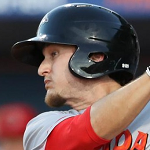 48. Riley Delgado, SS
48. Riley Delgado, SS
Age: 26 | Bats: R
2019: .282/.324/.323 | 95 wRC+ | 0 HR | 1 SB | 5.1% BB | 7.7% K (A+)
Acquired: Drafted, 9th Round – 2019
Prior Year Ranking: 35
Former Braves scouting director Brian Bridges once told The Platinum Sombrero Podcast that Delgado was drafted after Chipper Jones saw him hit at a collegiate showcase at SunTrust Park where the unheralded Middle Tennessee shortstop was lining pitches foul-line to foul-line.
This pretty much encapsulates Delgado’s offensive game. He’s the opposite of the “three true outcomes” style of player. He seldom strikes out, or walks, or puts the ball over the fence. His pitch recognition and strike zone judgement are among the best in the Braves system. It’s the unfortunate lack of other tools that has him ranked so low, combined with the 2020 minor league shutdown that likely cost him a season at AA.
Delgado is a steady infielder with good hands, and he’s played all three infield skill positions though an average arm and range means he’s probably best suited for second base. He is not quick on the basepaths, but will seldom run into an out either. In short, he’s the type of player that almost any manager would like to have on his bench, and there’s not a single Braves minor league player I would rather have at the plate when I absolutely had to have at least a single to win a game. He will likely start 2021 somewhere on the AA Mississippi infield.
49. Thomas Burrows, LHP
Age: 26
2019: 4.42 ERA | 3.96 FIP | 43 G, 0 GS | 57.0 IP | 3.79 BB/9 | 9.95 K/9 (AA/AAA)
2020: Spring-training invite
Acquired: Trade w/Seattle Mariners – 2017
Prior Year Ranking: 40
The University of Alabama’s all-time saves leader seemed like a sure-fire major leaguer after he shot up through three levels in 2018. Opening up 2019 in the high-octane offensive environment at Gwinnett didn’t do him any favors however, and he found himself back in Mississippi. He found his way back to Gwinnett before the end of the season and was better, and a spring training invitation showed that he was still on Atlanta’s radar, but he didn’t secure a spot on the 60-man player pool after the shutdown.
In 2019, using the major league ball, Burrows seemed to lose a bit of bite from his slider, his primary strikeout pitch. He needs that pitch to play off his mid-90s 4-seam fastball, and when that doesn’t happen he can get hit hard. This is the second off-season in a row that a team declined to take him in the Rule 5 draft, despite MLB’s never-ending appetite for left-handed relievers.
 50. Corbin Clouse, LHP
50. Corbin Clouse, LHP
Age: 25
2019: 5.65 ERA | 5.33 FIP | 21 G, 0 GS | 28.2 IP | 4.08 BB/9 | 11.62 K/9 (AAA)
Acquired: Drafted, 27th Round – 2016
Prior Year Ranking: 33
Clouse had a 2019 campaign to forget as persistent injuries combined with the rabbit ball limited his effectiveness just as it appeared that he was on the short list to make his major league debut. Clouse ended up having post-season surgery to repair a torn labrum, then follow-up surgery to clear scar tissue. Even if 2020 had been a normal season, Clouse would only have started throwing in April, aiming for a July 2020 return to the mounds. Instead Clouse went home to Michigan to continue his rehabilitation away from team doctors and trainers.
When healthy, Clouse features four pitches that all work at average to above average, a strong mix for a left-handed reliever. His best pitch is a hard slider that generates swing-and-miss, but before his 2019 shoulder issues he also was able to spot both his two- and four-seam fastballs for strikes, usually sitting around 93 with the four-seamer. He also had developed a nifty change-up that he was throwing with more confidently as he was able to spot it successfully. In 2019 however, his command went backwards and he lost feel for everything but the slider. If all goes well, he returns in 2021 with a healthy shoulder, he quickly regains the command that got him to AAA in 2018, and he makes this 49 ranking look terrible.
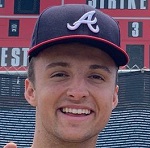 51. Ethan Workinger, OF
51. Ethan Workinger, OF
Age: 19 | Bats: R
Acquired: Minor League Amateur Free Agent – 2020
Prior Year Ranking: N/A
On the first day of teams being able to sign undrafted amateur free agents in 2020, the Braves were on the phone to Workinger at 6:00 AM local time. A Little League star, Workinger only had one abbreviated season at San Diego City Community College before agreeing to go pro with Atlanta.
Workinger is 6′-3″ and 185 pounds and looks to have plenty of room on his frame to add muscle. As it is, he had 11 extra base hits in 90 PAs in his 19-game run with SDCCC, with 2 stolen bases. He has a classic slugger’s swing and will likely add power as he matures. He’s likely to start the season in extended training, working to Augusta before the end of the season.
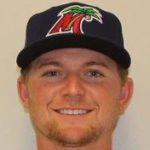 52. Jacob Pearson, OF
52. Jacob Pearson, OF
Age: 22 | Bats: L
2019: .233/.303/.338 | 80 wRC+ | 5 HR | 19 SB | 9.4% BB | 18.5% K (A/A+)
Acquired: Rule 5 draft (Twins) — 2020
Prior Year Ranking: N/A
A 3rd-round pick by the Angels in 2017, Pearson was traded to the Twins after his first pro season for international bonus pool money. Pearson was a star at West Monroe High School in Louisiana, but at least so far he has not been able to regularly tap into the hit and power tools that lead the Angels to invest a high pick and bonus in him.
Nevertheless the tools are still present and flash on occasion. Pearson shows a quick bat, but tends to get fooled on off-speed. His bat plane can generate backspin that will allow the ball to carry, but his approach is more pulled-line-drive oriented. He has good speed and baserunning skills, and can cover ground in the outfield though his average arm will likely keep him to left, center field in the best case scenario. Look for Pearson to start off at high-A Rome and battle for playing time.
 53. Geraldo Quintero, OF/2B
53. Geraldo Quintero, OF/2B
Age: 19 | Bats: S
2019: .264/.379/.376 | 116 wRC+ | 2 HR | 12.7% BB | 11.8% K (Rk DSL)
Acquired: International Amateur Free Agent – 2019
Prior Year Ranking: N/A
The 2019 international amateur class isn’t likely to go down as a great one for Atlanta as MLB sanctions on signing came to its most onerous, limiting Atlanta to only $10,000 signing bonuses. That doesn’t however mean there aren’t potential bargains to be found, especially out of Venezuela where the dangerous political climate has brought scouting to a near standstill, with all but a handful of teams suspending travel to the country even before this summer’s COVID-19 mandated moratorium. Nevertheless, one member of the class had a stand-out season for the DSL Braves in 2019. Quintero showed himself to being equally adept in centerfield and second base, giving the Braves some options as he moves up the organizational ladder. Standing at an Albies-eque 5’8″, 155 lbs, Quintero’s offensive game is currently working counts before trying to pull the ball.
Quintero will likely come stateside for 2021 and go to extended spring training, but we have also seen the Braves in the last few seasons be very aggressive even with very young DSL stars; in 2019, 18-year-old Carlos Paraguate and Darling Florentino were rushed to low-A Rome to start the season. I’m not certain that’s a great plan, but the precedent is there for Quintero to start in Augusta if there’s an opportunity.
54. Brandol Mezquita, OF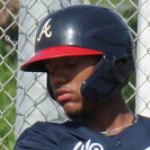
Age: 19 | Bats: R
2019: .246/.350/.280 | 93 wRC+ | 1 HR | 6 SB | 12.1% BB | 28.6% K (Rk GCL)
Acquired: International Amateur Free Agent – 2017
Prior Year Ranking: 48
Mezquita is the lone member of the 13 international prospects emancipated by MLB as punishment for the Coppalella scandal to return to the Atlanta Braves organization. Still in his teenage years, Mezquita has flashed tools — centerfield quality defense, an above average arm, good bat speed, and good wheels. With his body type he should add raw power to that mix as well. What he needs more than anything is game experience and for his body to continue to fill out. Currently he strikes out and grounds out too much for any of the offensive tools to really show, but he’s obviously still extremely raw.
Look for Mezquita to start the season in extended spring training, but a strong spring could see him to low-A Augusta before the 2021 season closes out.


